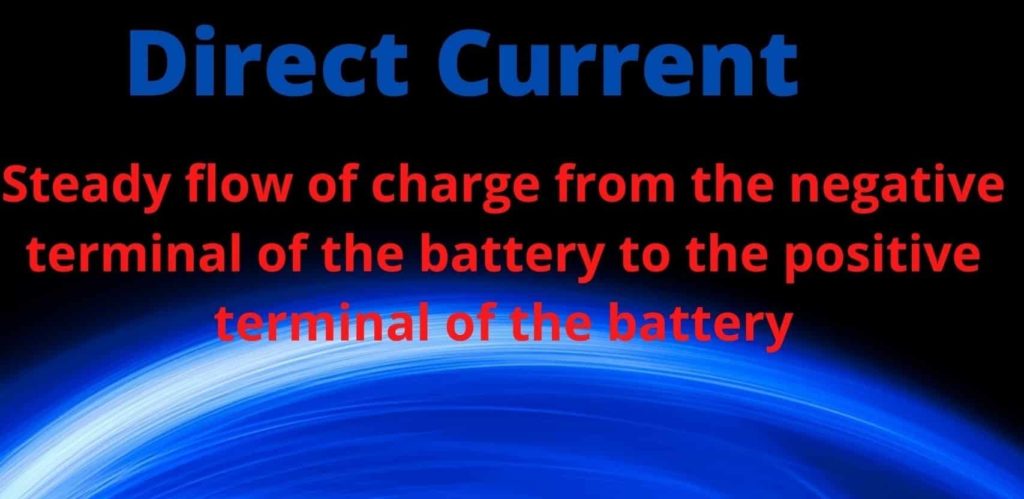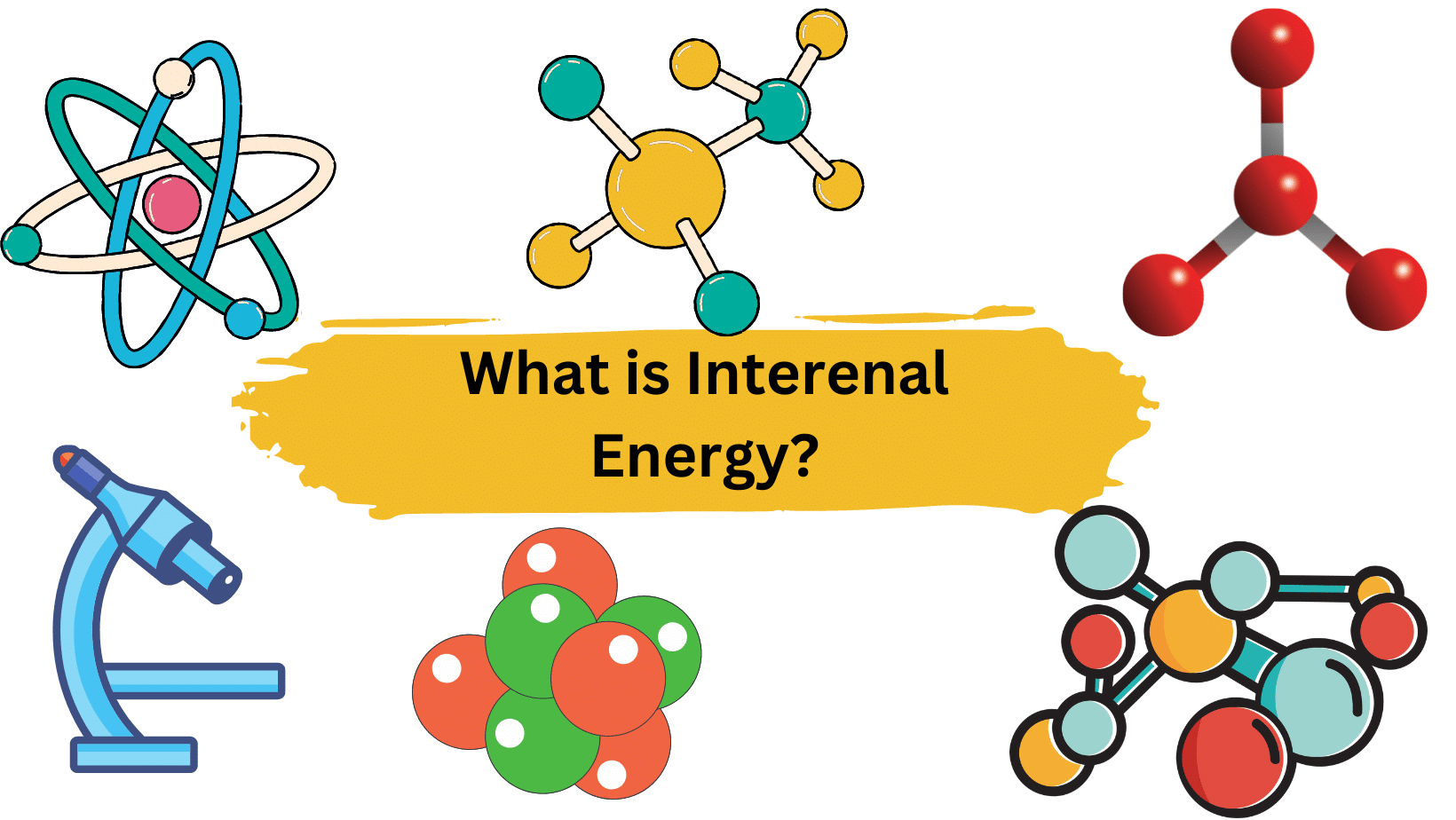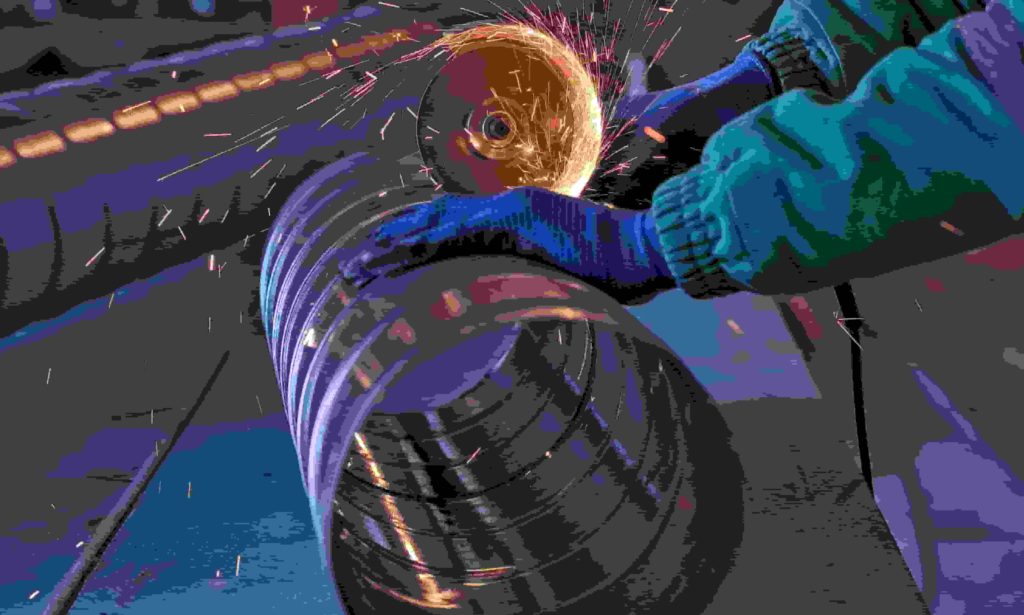The unidirectional movement of electric charge is known as direct current (DC). Batteries, thermocouples, solar cells, and commutator-type electric machines of the dynamo type all produce it.
In simple words, the steady flow of electrons from a high electron density area to a low electron density area defines direct current.
In terms of circuits involving batteries, direct current refers to a steady flow of charge from the negative terminal of the battery to the positive terminal of the battery.

Table of Contents
Direct Current
The term Direct current refers to power systems with only one polarity of voltage or current and the constant, zero-frequency, or slowly fluctuating local mean value of a voltage or current in electrical engineering. It is much more costly and difficult to change the voltage of direct current as compared to alternating current, making it an unsuitable choice for the high-voltage transmission of electricity. However, for very long-distance transmission, direct current can be more efficient than alternating current.
Furthermore, many low-voltage applications use Direct current, particularly where they are supplied by batteries, which can only create Direct current, or solar power systems, which can only produce Direct current. Although the alternator is an Alternating device that requires a rectifier to produce Direct current, most automotive applications use Direct current. A Direct current power supply is required for most electronic circuits.
Direct Current in Simple Terms
Direct current (DC) is a type of electrical current that flows in one direction. This means that the flow of electricity, which is carried by tiny particles called electrons, moves in a straight line.
Some key points about DC are:
- It only flows in one direction
- It is commonly produced by batteries and generators with commutators
- It is used in many electronic devices and transportation systems
Real-Life Examples of Direct Current
Some examples of where you might encounter direct current include:
- Flashlights and other battery-powered devices
- Cars and trucks with electric starters
- Solar panels that produce electricity
- Some types of trains and subways
Applications of Direct Current
Any electrical gadget using a battery as a power source uses direct current. This type of current is also used to charge batteries, which is why rechargeable gadgets like laptops and mobile phones have an AC converter built in that converts alternating current to direct current.
Fuel cells (which combine hydrogen and oxygen with a catalyst to generate electricity and water as a byproduct) also produce solely DC.
Related Formulas
| V = I x R | Ohm’s Law: relates voltage (V) across a resistor to the current (I) flowing through it and the resistance (R) of the resistor. | LED lighting, electronic devices, power supplies, motors, and battery charging. |
| P = V x I | Power Law: relates the power (P) dissipated by a device (such as a resistor) to the voltage (V) across it and the current (I) flowing through it. | Power generation and distribution, electric heating, electric vehicles, electronic devices. |
| ΣI_in = ΣI_out | Kirchhoff’s Current Law: expresses the conservation of electric charge at a node in a circuit. The sum of all currents flowing into a node must equal the sum of all currents flowing out of the node. | Circuit analysis and design, circuit troubleshooting. |
| ΣV = 0 | Kirchhoff’s Voltage Law: expresses the conservation of the energy around a loop in a circuit. The sum of all voltage drops around a the closed loop must be zero. | Circuit analysis and design, circuit troubleshooting, and power supply design. |
Summary
- Direct current (DC) is a type of electric current that flows in a single direction through a conductor.
- DC is used in various applications, including power electronic devices, charging batteries, and driving motors.
- Ohm’s Law relates voltage, current, and resistance in a circuit, and Kirchhoff’s Laws describe the behaviour of current and voltage in a circuit.
- DC is used in a wide range of industries, including telecommunications, automotive, and aerospace.
Frequently Asked Questions
1. What is surface charge density?
Surface charge density (σ) is the amount of charge per unit area, measured in coulombs per square meter (C⋅m−2), at any point on a two-dimensional surface charge distribution.
2. What are Kirchhoff’s laws in simple words?
Kirchhoff’s laws are rules that help us understand how current and voltage behave in an electrical circuit. Here’s a simple explanation of Kirchhoff’s laws:
- Kirchhoff’s Current Law (KCL): The sum of currents entering a node (a point where two or more wires meet) must equal the sum of currents leaving the node. This means that the total amount of electric charge flowing into a node must be equal to the total amount flowing out of it.
- Kirchhoff’s Voltage Law (KVL): The total voltage around any closed loop in a circuit must be zero. This means that the voltage gained by moving through a component must be equal to the voltage lost by moving through another component in the same loop.
In other words, KCL ensures that electric charge is conserved at a node in a circuit, while KVL ensures that energy is conserved around a loop in a circuit. These laws are essential for analyzing and solving problems in electrical circuits.
Exams Related Questions
| 1 | Direct current (DC) is the flow of electric charge in only one direction. | What is direct current (DC)? |
| 2 | DC can be produced by sources such as batteries, fuel cells, and solar cells. | Which sources can produce direct current (DC)? |
| 3 | DC voltage is constant, meaning that the voltage level does not change over time. | What is meant by “constant voltage” in direct current (DC) circuits? |
| 4 | In DC circuits, current flows from the positive terminal to the negative terminal of the power source. | In which direction does current flow in DC circuits? |
| 5 | DC circuits can be simple or complex and can include components such as resistors, capacitors, and inductors. | What types of components can be included in DC circuits? |
| 6 | DC circuits obey Ohm’s law, which relates voltage, current, and resistance. | What law describes the relationship between voltage, current, and resistance in DC circuits? |
| 7 | DC circuits can be analyzed using Kirchhoff’s laws, which relate currents and voltages in a circuit. | What laws are used to analyze DC circuits? |
| 8 | DC circuits can be used in many applications, such as lighting, motors, and electronic devices. | What are some common applications of DC circuits? |
More Links
- BCl3 Lewis Structure in four simple steps - November 1, 2023
- PH3 Lewis Structure in four simple steps - October 8, 2023
- PF3 Lewis structure in four simple steps - September 24, 2023



